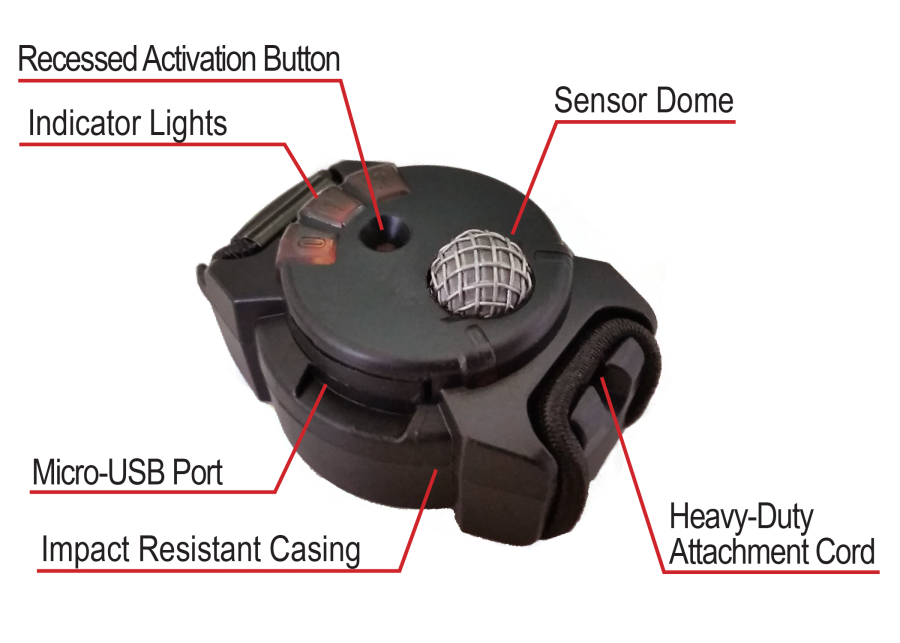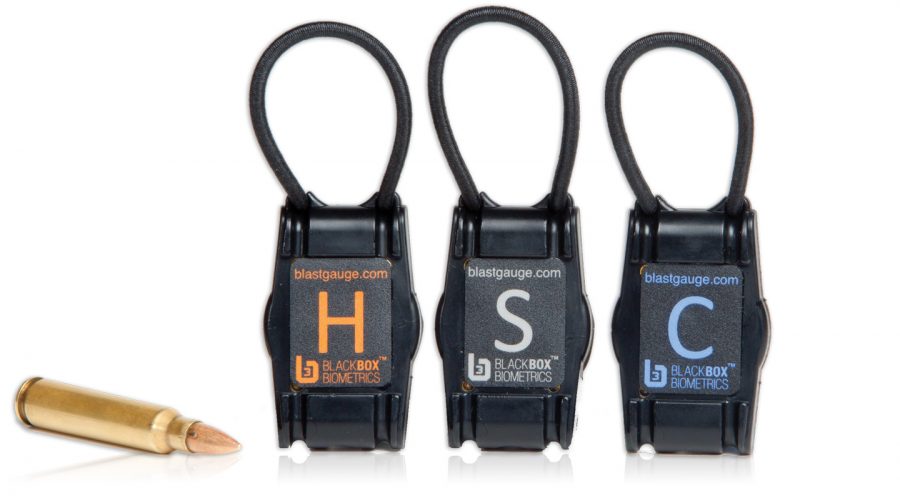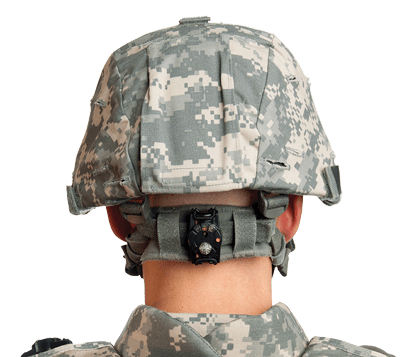I can’t tell you how many times I’ve been asked about the relative concussion levels of the 160-some-odd muzzle devices I’ve tested for recoil and flash. Unfortunately, I’ve had no way to respond other than with my subjective opinion on how they felt. That’s about to change, thanks to a device made to protect our men and women in uniform. It’s called The Blast Gauge System, it’s made by BlackBox Biometrics (B3), and here’s the TL:DR version of what it does…
The Blast Gauge sensors record overpressure — spikes in air pressure generated by a concussive force like a bomb or IED, artillery or missile fire, flashbangs, breaching rounds, and more — as well as acceleration. These units can measure changes in psi in 0.05 psi increments up to 110 psi of overpressure, which is 10% higher than the threshold at which deaths begin to occur. The Blast Gauge system graphs and logs overpressure events, and all of the data can be downloaded to a computer or mobile device.
As traumatic brain injury can happen at fairly low pressure levels and repeated exposure can have a cumulative effect, these sensors are designed to track military or police personnel exposure and provide warnings and information to medical staff. As seen in the photo above, the system is designed to be a 3-sensor set worn on the head, shoulder, and chest. The sensors can alert medical or other teams wirelessly, or can simply be checked visually via color-coded warning lights for notification that medical evaluation may be necessary.
There’s a whole heck of a lot more information on the Blast Gauge website, including a significant amount of scientific research into overpressure and its effects on the body and brain and various uses for the Blast Gauge System (e.g. use multiple gauges to map how a flashbang propagates pressure inside of a home to determine how to use them more effectively and safely).
I’ve purchased two of the wireless gauges and will be using them to capture objective, accurate data on the concussion generated by various AR-15 muzzle devices. The plan is to place one off to the side to mimic what a team member near the shooter (or a neighbor on the range) would experience, and one where the head of the shooter would be. This will result in graphs of the concussive force for each muzzle device, plus a peak overpressure measurement in PSI. Cool, right?







Can’t wait to see the new test especially with the winners of the last batch of testing.
hmm. If I cannot check my email on it, I don’t want it.
Very cool. Kudos for the outside-the-box thinking here (I doubt the inventors thought of using them in this fashion).
Jeremy – Good thinking…well done! I’m looking forward to reading your findings.
Data-driven analysis; I approve.
OK, that’s pretty neat.
If you are still testing that big fifty, I’d love to see some readings from that!
I’d like to see just how louder .44 mag is to .357 mag.
And how loud the big-boy revolver calibers are…
This is just a sound pressure level meter. “Spikes in air pressure” *is* sound. You should be measuring dB here, which is log-scale, not PSI. Look up ‘webers law’ to see why.
A simple calibrated dB meter would do you just as well.
I’ll definitely be using them for other testing as well. But to be extra clear just in case, these don’t measure volume level (“louder”). If all goes to plan, beginning in ~February I’ll have access to professional dB measuring equipment as well, though. At this point I sort of have to decide whether to do an overpressure test in Dec/Jan or wait until February when I can do a combo overpressure & dB level test. As excited as I am to get my hands on this Blast Gauge units (they should arrive in early Dec), I’m leaning towards postponing the test until I can include the dB data as well and do it all at once.
It will be really interesting to compare the PSI measure from this device with the dB measure. I’m mostly curios how sensitive these ‘blast meters’ are. I look forward to reading about your setup to do this!
My body is ready. Proceed.
“Thank you sir, may I have another?”
“Again!”
This is sort of gimmicky right?
This is just a sound pressure level meter. “Spikes in air pressure” *is* sound. You should be measuring dB here, which is log-scale, not PSI. Look up ‘webers law’ to see why.
A simple calibrated dB meter would do you just as well.
DB meters that are fast enough to accurately capture the rise-time of the gunshot impulse are very expensive..
True, but cheap computing is readily available to the hobbyist/hacker. It’s an off-the-DigiKey sensor, and some basic components to make the output acceptable to the I/O port on a RasperryPi. Little bit-o-code and, voila!
I’m not savvy enough to direct hack a Bosch L-Jet brain and read the code. But I did take a few simple breadboard circuits, a c-note in parts, and a ~$300 data acquisition unit and interpolate the tables using an (homebrew) interceptor box, and a bunch of banana jacks.
Take that thing apart and it’ll be unimpressive in the extreme.
I understand this line of thinking and I don’t know enough about this area of physics to be sure how that would work. When I do actually dB test these brakes with a professional metering setup, which I will do in Q1, am I going to find a perfect, scalable correlation between dB measurement and concussion/overpressure/shock wave measurement via the Blast Gauge? Have you ever seen an equation that can convert dB into overpressure (e.g. 164 dB = 1.5 psi over atmosphere pressure shock wave)? No…I don’t think they’re directly related. I basically expect that some loud muzzle devices will create less concussion than some quieter ones. Or maybe not and I’m totally off base there.
BUT…A shock wave isn’t a sound wave, even if a shock wave creates a noise. If a shock wave were a sound wave, it would travel at the speed of sound. But it doesn’t; it travels at the speed of whatever caused it and that’s often much faster than the speed of sound (e.g. a shock wave caused by the expanding gasses of an explosion).
An example would be a the shock wave (sonic boom) caused by a supersonic aircraft. That overpressure wave will rattle the windows of your home, you’ll feel it in your chest, and you’ll hear it (which could even be mostly from the effect the shock wave has on physical objects just like knocking on your window would make noise but it doesn’t mean your hand moving through the air towards the window makes noise) way before you hear the sound of the airplane itself. The sound of the boom has nothing whatsoever to do with how loud the plane is. In this same respect, if I want to measure concussion I don’t want to measure how loud the gunshot is. It isn’t the noise of the gun that’s creating the concussive force, it’s the supersonic projectile and supersonic gasses expanding behind it. Those expanding gasses create the shockwave in the air — it’s actual particles or objects that create a shock wave, it isn’t just a noise.
BTW even if your theory is solid and sound pressure and shock waves are conceptually similar enough to “dB” meter them both, shock waves may be at such a different frequency range that it’s entirely outside of the scope of any dB meter. They’re obviously made to register sounds within the human hearing range (or even just a specific part of that range). So call this Blast Gauge system silly for using PSI instead of dB all you want, but I’m not convinced 1) there’s a dB meter on earth that can measure a supersonic blast wave and 2) there’s actually a correlation between the volume of the source and the pressure of its blast wave, since the volume of the source (gunshot in our case) doesn’t have to have any correlation with the speed of the object/particles that are solely responsible for generating the shock wave (the projectile and the expanding gasses out of the muzzle, in our case).
Jeremy,
I appreciate the thorough response here.
I use dB meters, and deal with sound all the time. I don’t want to get into this too much, as I’d like to remain somewhat anonymous, but I have a phd in bioacoustics so I have a great deal of familiarity with the subject here.
I’ll just address a couple of points.
First, a dB meter is not always made to measure only the energy in frequencies that humans can hear. Usually they aren’t made that way, actually. So when you measure dB (you don’t have to use a dB meter- you can use just a microphone and an oscilloscope) you are measuring the amount of pressure in the air- which includes the pressure you can’t hear. All you are doing is pushing the membrane of a microphone (dB meter or not). So when you describe the windows rattling when a plane flies by, that is caused by sound. Not sound you can necessarily hear, but compression waves through the air none-the-less. The membrane of the microphone on your meter will move just the same as the window moved. And when you move your hand through the air to knock on a door, you are moving air out of the way, and creating compression waves as you do that- so you are also creating sound, just at such low levels we can’t typically hear it— but it’s still sound, and I can still measure it.
Second, dB is a measure that has to be defined. Usually when we say “dB” we mean “dB SPL” which is relative to micro pascals, which is a measure of pressure. So yeah, you can correlate dB to PSI, but we don’t because dB is in the log scale, which is far more useful and meaningful (look up Webers Law).
now- MOST IMPORTANTLY- when you say it is expanding gas and particles from the firearm that are creating the shockwave… what do you think is creating the noise? It’s those same things, because we are talking about the same thing.
If you have any questions about any of this or want some clarification or help with your dB testing or anything, feel free to email me. And thanks again for the lengthy response, you obviously care about this. 🙂
Okay you win 🙂 I bow to you sir. I hope for the purposes of the comparative testing I’m planning on doing, using the Blast Gauge system to measure overpressure/shock wave and a legit dB meter setup to measure how loud the gunshots are will work properly and provide results that are easy to understand.
Yes, there is an equation that calculates sound level from air pressure.
http://www.engineeringtoolbox.com/sound-pressure-d_711.html
The .05 psi resolution of this sensor is unimpressive. The units of air pressure used to calculate sound level is the pascal, which is .000145 psi. I doubt you could use this to calculate any relevant sound pressure level because it isn’t sensitive enough in most of the auditory range. This is probably because it was designed to survive pressure spikes that would stop your heartbeat. Such pressure would likely cause an SPL meter to fail, making the two more complementary. I don’t know if a sensor could be made that would bridge the gap between auditory safe and nuclear blast while still being accurate, I suspect so, but I don’t think this is it.
i THINK you’re on the right track with the Blast Gauge System. Cdotson is right however: microphone based SPL meters might be ruined by overpressure, the same way burst discs operate.
A MEMS based mic I looked at on Digikey “clips” at 133 dB SPL http://www.digikey.com/en/product-highlight/i/invensense/inmp621-mems-digital-microphone. Even if this type is not damaged, it certainly won’t provide useful data above that. This article http://www.elcaudio.com/decibel.htm by Eric Carmichel may be useful in understanding why.
I’m curious about the technical specs of the Blast Gauge System: what is the maximum SPL or pressure wave that IT can handle without saturating/clipping? Also wondering why the Army has shelved the Blast Gauge System after reports that soldiers are subjected to damaging overpressure from their own weapons.
Comments are closed.